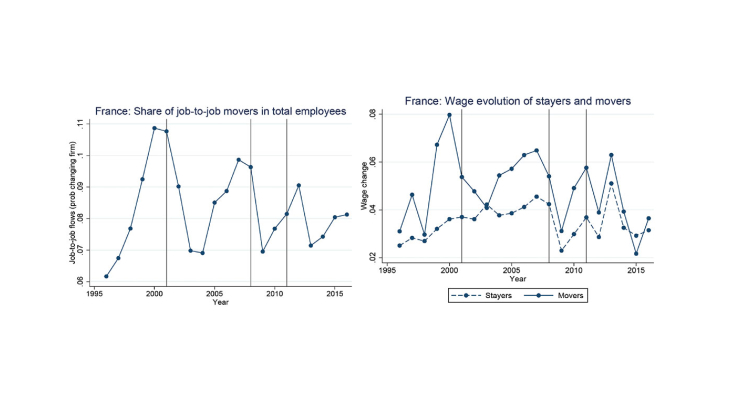We analyze the correlation of observed job-to-job flows and local shocks, measured by variations in the local unemployment rate. We consider the probability to move to another job, the average wage gain associated to a move and the specific relation of movers' wages with local shocks as opposed to the one of stayers. In our simplest empirical model, the correlation of wage changes with the economic situation is captured by variations in the local unemployment rate where the individual works. We find that in Italy the probability of moving is highly correlated with the local unemployment rate but not in France. In both countries, movers gain on average an extra 2 pp. increase in nominal wage growth when they change job. Moreover, this wage gain for movers is significantly negatively correlated with the local unemployment rate. Wage changes of stayers are in general not very responsive to changes in the local economic situation. Comparing France and Italy, we find that job-to-job flows are larger and more correlated with local unemployment in Italy than in France; wage premia instead respond similarly to changes in the local unemployment rate in both countries.
To understand what drives our results, we look at relevant dimensions of heterogeneity. We find supportive evidence that job-to-job flows of workers in high-skilled occupations are more frequent and more sensitive to local economic situation. We also find that temporary workers represent a large share of those who change job, notably because they are forced to look for another job after their contracts expire. The premium from moving, however, is higher and more correlated with the local unemployment rate for permanent workers. We also test whether wage dynamics is influenced by firm characteristics. However, we do not find a clear pattern of job-to-job flows by firm size contrary to the literature. If anything, we find that job-to-job flows are more cyclical for small firms. As in Fort et al. (2013), we find that young, small firms poach from other firms, and that both inflows and wage gains are highly and positively correlated with local shocks.
We then look at the existence of the strategic effect, i.e. the reaction of stayers' wages to changes in the average probability of experiencing a job-to-job move in their labour market, as well as of experiencing a change in the average probability of exiting and entering employment in their labour market. We follow MPV (2017a) and, for different types of workers, we calculate a time-varying average probability to register a job-to-job move, a transition from employment to non-employment or a transition from non-employment into employment. We find that flows from job-to-job affect wage growth of both stayers and movers, coherently with the so-called "strategic" effect, as in MPV (2017a). Differently from them, however, we also find that wages respond to variation in potential flows from and to non-employment (which determine changes in the unemployment rate).
Based on our full set of results we conclude that –differently from what observed in the US–transitions into and out of non-employment remain a key determinant of aggregate wage growth. This result supports the validity of the standard Phillips curve specifications. Research about the Phillips curve, however, should also consider the potential impact of job-to-job flows and firm characteristics on aggregate wage growth.
